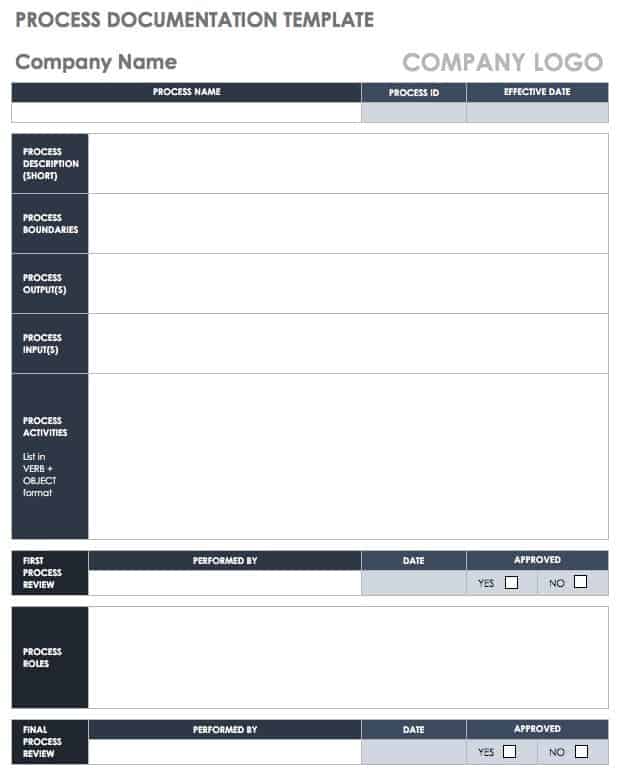What Is Process Documentation?
Process documentation is a method for capturing the necessary steps to complete a process or tasks. It is critical for businesses because it increases consistency and allows your staff to learn from both their successes and their mistakes.
A business process comprises all of the tasks that lead to the delivery of a specific product or service. Since it is a crucial part of business process management, your staff should perform process documentation as it occurs.
Process analysis is a review that gives you a complete understanding of your process. This kind of analysis illustrates not only how you perform a process, but also why you perform one. You must study, analyze, and fully grasp the process. Once you have figured this out, you want to process map — the visual part of your documentation. Process maps are a graphic representation of the relationships between steps, inputs, and outputs. However, the information in a process map is not comprehensive — it doesn’t capture every aspect of a process. Items the map doesn’t cover include any bottlenecks or exceptions, details about ownership responsibility for tasks and activities, the acceptable durations of various activities, and the methods your staff members employ to find resources and accomplish tasks. Process documentation fills in these particular gaps. For more information on process mapping, read the "Essential Guide to Business Process Mapping." You can express your process maps in flow charts and in business process modeling and notation (BPMN) symbols.
Flow charts are sequential pictures of your workflow steps. There are no hard and fast rules for developing flow charts. Based on your company’s needs, you can use a series of arrows or more formal symbology to create flow charts. For more information on creating flow charts for your workflows, read "Save Time by Taking the Time: Creating Workflows." BPMN is a standardized language of symbols for process development. Like any other language, BPMN has a defined vocabulary and organizing principle. The stories that BPMN tells are all about your work and its flow. BPMN can be a large part of your process documentation if you choose to use it for modeling. For more information on BPMN, read the "Beginners Guide to Business Process Modeling and Notation (BPMN)."
Process modeling is also a visual representation of your work processes. You can use less formal workflows or BPMN. Many people use the terms process mapping and process modeling interchangeably. Much like process mapping, process modeling lays out your processes, looking at the inputs, outputs, and consecutive organization, trying not to leave out anything. Process modeling takes you further by proposing new process flows. You model the processes as they are now (as-is), and then you model them how they need to be to maximize their efficiencies (to be). You can vastly improve your business by using process modeling to find and visualize ways to be productive. Not only is process modeling part of BPM, but it is also part of business process remodeling (BPR). BPR is a structured approach to improving your processes. BPR has been around a long time, and many consider the approach a radical form of improvement because it revamps from the ground up. For more information on BPR, read "A Newbie’s Business Processing Reengineering Guide with Expert Insights."
These seemingly disparate but overlapping BPM disciplines have two main things in common: One, they all intend to capture what you and your company are doing not only for posterity, but also for improvement purposes; two, they all add to your process document(s). Even the method you go through to decide and improve your processes should be captured because it shows your thought process and the trial and error that bring you to current operations. You’ll also want to capture your document review method, including all of its iterations and approvals. A process document does not have to be complex, however — even the steps that outline the process of boiling water can serve as a process document.
The length of a process document varies. It’s important to remember that process documentation requires a level of detail that can produce the same outcome every time, even if the personnel changes. This level of detail of course dictates the length of your process document, not the arbitrary setting of a specific number of pages.
To avoid any confusion regarding terminology, here is a short primer on the difference between project documentation and product documentation. Project documentation is specific to your managed projects. A project is defined by the fact that it has a specified beginning and end. The documentation in a project is critical to the project’s stakeholders in that this record helps ensure that your company is fiscally responsible regarding its project funds. Product documentation defines exactly what a product should do. This type of documentation is used primarily for software products in the technology sector and is even required for compliance to some standards.
What Is Documentation in a Business?
Business process documentation is a roadmap. You can use it to show how the process is today (as-is) and how it will be after you make improvements (to-be). We’ve outlined additional business process documentation use cases below:
- Value Chain: These are the customer-initiated, large-scale business processes that deliver a product or service. They help your business calculate its profit margin by including all of the pertinent steps and their attendant delivery costs. For more information on value chains, read “The Art of Value Chain Analysis: From Defining Activities to Identifying Areas for Improvement.”
- Insight into Your Company: Whether the insight is for management, employees, or your customers, you can see exactly what goes into your deliverables.
- New Employees: You can use your process documentation as training for your new employees and to ensure that institutional knowledge is shared. Further, your new employees will understand how they fit in overall.
- Social Change Projects: For social change projects, process documentation is critical. This documentation records the perceptions of stakeholders in a way that ensures objectivity.
- Compliance with Regulatory Requirements: This may be the main reason to document your processes — because you are required to do so.
John Miller, Director of Sales and Operations at Shelter Works, says, “We use process documentation because it answers several critical questions:
- Why do we need to change?
- What do we need to change?
- How do we need to change?
Through these questions, we inevitably see areas for improvement.
I have personally been using process documentation since 1997, having studied Six Sigma and Lean processes. (Process documentation is integral to the whole Lean system.) At Shelter Works, we use process documentation extensively in strategic planning because it allows us to think about what we're currently doing and plan for future growth. If you don't understand how you are currently doing something, then you can't put a plan in place to improve it.
One of the most critical activities in process documentation is staying focused on what you’re trying to accomplish. Don't get distracted by areas outside of the project scope. It's easy to get sidetracked trying to improve the process as you are documenting the process you already have in place. It's important to completely document the process first and then go back and look for ways to improve it. For us, ownership of process documentation is held at a very high level, at the level of Director of Sales and Operations, because it is a key component to building the right long-term strategy.
We use a combination of traditional flow chart mapping, Lean value stream mapping, and Theory of Constraints current state and future state mapping. The biggest issue is thinking that you know what the processes are when you really don't. Process documentation challenges everyone's assumptions and forces you to think really honestly and clearly about that process.
I would tell anyone new to process documentation that it's going to take time, and it's important that you follow through thoroughly. You will probably need to go through the process several times before you have fully documented the process. While it's nice to get outside input, it is critical to get input from the people involved in the actual process. They will be able to provide insights into nuances to make sure that your process mapping is thorough. If you are getting outside input, make sure you verify the process with the people who actually perform the process."
What Is the Goal of Process Documentation?
The goal of process documentation is to identify improvements to make your business more consistent in both the short and long-term. From eliminating flaws to decreased costs, here are some examples of other goals that process documentation can achieve:
- Help you keep track during project execution
- Help you learn from implementation
- Eliminate any flaws
- Reduce the time on a task
- Decrease costs
- Decrease resources needed for tasks
- Improve efficiency
- Improve quality
- Increase customer and employee satisfaction
- Help you understand necessary changes in behavior or attitude
- Help you understand intent
You should be looking for only those opportunities to document that make sense. Unless you have a specific regulatory requirement, you don’t document just for the sake of documenting.
I have implemented a process that we started using this year. It's one of the most effective strategies I’ve used in over a decade of being a business owner. We use programs like Microsoft OneNote to manage all our processes. I like to record videos and write detailed systematic instructions for each process. If it is a simple process, then we just write detailed instructions. If we use video, we upload the video to YouTube as an unlisted video, so only people with the video URL can see it. Then, we copy the video URL and add it to Microsoft OneNote, along with the step-by-step instructions.
For example, using Microsoft OneNote is great because you can create sections for different parts of your company and only share the sections with employees who should have access to them. You can also share these sections with third-party contractors if you want. This method creates an organized guide with the most essential processes for your company."
Who and What Is Involved in Process Documentation?
Everyone in your organization should be involved in some part of process documentation, even if they’re only documenting their daily duties. It may differ by project, but generally, the people and factors involved in process documentation are:
- Project Team: These are the people inside your company. However, experts recommend that your documentation be owned by someone on your project team who is not involved in its daily performance. This way, that owner can focus on recording processes, organizing your information, and ensuring that the other team members record their learnings during the project.
- Stakeholders: Especially concerning specific projects, your stakeholders need to have a format from which to learn about other perspectives and experiences.
- Outsiders: One advantage of including outsiders in your process documentation is that they can often give a clear, unbiased perspective. Of course, we’re not talking about just any random outsider, but rather professionals who are versed in your field or material. It may be valuable to hire an outside consultant for a review.
- Materials and Resources: You must think of your materials and resources as a person or group of people involved in your process documentation. They should be set aside for use during your documentation, not treated negligibly. For example, if you plan to document using video, you should have the appropriate cameras and recorders.
- How to Work Together: One often ignored part of documentation is how you get people to work together, specifically how you get them to communicate. Assigned roles go a long way toward getting this part right.
- Pulling It All Together: Just like your projects, your documentation must have a plan from the beginning. You must consider the who, what, where, and when regarding every part of your process, and you must put documentation rules into place for your business.
Everyone handles tasks differently, so it is likely that some individuals may be more resistant to process documentation than others. Keeping accurate records guarantees that you meet the standards your company upholds. Still, some employees might need more encouragement to keep their documentation up to date.
Process documentation is essential for companies of any size. It ensures that every member of your team performs with quality and consistency, and it leaves less room for error or confusion. Having well-documented processes allows employees of any experience level to pick up tasks with confidence. At Anderson Technologies, we fully embrace documentation at all levels and for all tasks, both internal and client facing.
In our experience, it is easier on yourself and your employees to record processes as you are doing them step by step rather than waiting until a project or task is completed. The details of the process are much clearer and more accurate in the moment.
Our most valuable tool is documentation software that optimizes our system administration and information technology processes. We house contacts, configurations, vendors, credentials, license keys, and standard operating procedures in one handy program, and our tool’s clever tagging tools and fast search capabilities make information easy to find.
The best mentality you can have when beginning process documentation is this: Take it one step at a time. If you approach company-wide process documentation, it can seem overwhelming and intimidating. Instead, try organizing the facets of your company into a high-level outline, so you can work on a section at a time and fill in the gaps as you go."
The History of Documentation and Its Requirements
The term process documentation, or standard operating procedure, was first coined in the mid-20th century. However, the roots of technical writing can be traced back to antiquity. Aristotle detailed processes of philosophical importance. In the 1300s, Chaucer’s A Treatise on the Astrolabe became the earliest recorded English technical documentation. In 1978, The Philippines National Irrigation Agency used the term process documentation to describe the processes of their farming project. Clearly, the process of recording the things we do to ensure they are performed the same way to attain the same results has been around a long time. For several decades today, more serious industries require documentation. Many industries, such as manufacturing, banking, and oil and gas have requirements in place to record what they are doing and ensure compliance with safety and financial regulations that protect the public.
The Benefits and Challenges of Process Documentation
What we have not yet discussed is the reality of process documentation. Many companies feel a push and pull between trying to do the right thing by documenting and trying not to waste resources by documenting. Some industries have strict documentation protocols due to their regulatory requirements. For example, in the banking industry, process documentation is strictly controlled. Currently, banking experts complain that auditors require them to document not only processes but procedures as well, sometimes with little regard as to why or if it is best for the business. With these facts in mind, here are the benefits of process documentation:
- It allows for continual and timely changes in processes to increase productivity.
- It prevents procedures from going unused due to a lack of understanding.
- It conserves knowledge, even when those involved in the process leave the company.
- It helps figure out if processes are efficient or if certain steps need to be eliminated or revised.
- It assists all members of an organization in understanding processes and knowing who to contact with problems when they have them.
- It improves your security.
- It makes it easier to maintain standards and consistency, follow external rules and regulations, and support due diligence efforts.
- It serves as a practical teaching tool for your new hires.
- It offers context regarding individual projects.
- It encourages debate about your current processes.
- It allows for outsourcing because you can easily transfer knowledge.
- It encourages everyone to be involved.
- It inspires reflection and learning.
- It provides voice and local context.
- Selfish Desire to Own the Keys to the Kingdom: This cultural and management problem needs to be dealt with from the top down. No business can scale if a single employee is the only one that can run a particular process.
- Perfectionism: People that lack technical writing or project management experience overthink what needs to be done. The reality is that something as simple as a one-page document or spreadsheet is a really good place to start. Sure, you can always add screenshots and screencasts later. Perfection is the enemy of completion.
I got my first real taste of process documentation when I wrote a book for Microsoft Press. The book was a how-to guide for small business computer service providers and managed service providers (MSPs) about how to build a business around Microsoft’s all-in-one small business suite (Microsoft Small Business Server/SBS). Half the book was technical process documentation — including how to install and customize different parts of the server suite. The other half of the book was about the business development process (marketing, project management, hiring, subcontracting, and service agreements, for example).
With three editors on the Microsoft Press side and an outsourced team of technical editors and designers from the book-packaging vendor, I learned a ton about the editorial process while writing a book that was all about process documentation.
Interestingly enough, the CD-ROM in the back of the book (this was 2000), which contained a few dozen worksheets, templates, and forms, proved incredibly popular with readers looking to jumpstart their own process documentation.
For someone new to process documentation, I would say, ‘Just start. There is always room to improve later.’ However, even mediocre process documentation is better than no process documentation. I also learned to use tools. These are some of my favorites:
- Image capture and cropping software
- Screen casting capture and production software
- Project management software templates
Over the years, I have seen many process documentation challenges. The biggest one is how to keep documentation current. Our best practice is to put a recurring task in the project management system to review every 90 days. Another process documentation challenge is that it is frequently pushed to the back burner.”
Aside from the challenges that Feinberg points out, there are also other concerns:
- Stakeholders behave differently when they know what they say is being included in process documentation. They may leave out small things that could actually be critical for accomplishing the process because they feel that these things don’t make them look good.
- The person recording a process may not fully understand it themselves.
- Special interest groups can use process documentation to start trouble.
- Process documentation can slow down a project.
- Your documentation can have a short shelf-life before it needs to be updated again.
- People may expect compliance simply because the process is documented.
- Outcomes may be biased.
- Documentation may slow down some projects when you are on a tight deadline and budget.
- Documentation may be used to incite conflict.
- Badly written processes cause more problems.
- One may not explain the purpose or motivation behind the process.
- Leaving out information makes the documentation useless.
- People may include unnecessary or distracting information.
Tools for Process Documentation
To ensure that your process documentation does not exist in a silo in your company, you need to carefully consider the tools that you choose to use. Your process documentation should be flexible and, above all, available to your people. In addition, you need to ensure that the tools you choose actually encourage use. To make sure you achieve this goal, your tools should meet the following criteria:
- Be easy to access and share
- Make collaboration easy
- Be mobile-friendly
- Be online or available via your intranet
- Be able to perform more than one function
- Be user-friendly
- Strike a balance between simple and functional
The different types of tools address ways to do the following:
- Capture Process: This not only includes the written recording, but also the verbal and physical directions.
- Organize Information: You need a way to sort through the information and easily access it.
- Visualize Process: This includes diagramming, charting, mapping, and modeling.
- Distribute Information: This is your email function or document-sharing. It may also include dissemination channels.
“There are some great tools out there to create process documentation and mind maps of our ideas and to flesh out processes for things. I recommend one that has all the documentation in one place. It is great because you create a list of tasks and, within each list, you can add details, pictures, videos, and more.
Someone new to processes should know that it is important for any business to create and document a process for every task. This will allow any new employee to quickly catch up in case you lose an important staff member. You can easily go and check the process and steps they took to accomplish their tasks, so another employee can take over and learn the ropes. It also helps to have a document as a sort of checklist to make sure the job is done correctly and thoroughly.
I work at a digital marketing agency, and I believe documenting processes has been hugely important to the success not only of our company, but also of our clients. We have multiple different businesses that we do marketing for, and being able to have go-to processes for everything makes life so much easier. I handle creating and documenting most of the processes that we use, from onboarding a new client into our SEO retainer to helping a client prepare for their holiday ad spend. We use processes for every part of the company.
A Step-by-Step Approach to Make a Process Document
As we explained earlier, your process document should reflect the specific needs of your company and be as short or long as your company needs. Whether or not you use a template, your document should also have some loose structure to it. One of the best tips that experts give us is to include the right people in creating the process. For most documents, the sections of this structure should include the following steps or stages:
- Step 1 - Process Name: Make sure this name is easily identifiable for your staff.
- Step 2 - Process Boundaries: This includes the start and endpoints. The need for the process is not a part of the process.
- Step 3 - Process Output(s): This is the result as identified by the process purpose. Output(s) may not be a formal part of the process, but they are an important part of the documentation of the process.
- Step 4 - Process Input(s): This is what initiates the process and where it comes from. Again, the inputs may not be a specific part of the process, but they are a critical part of the documentation of the process.
- Step 5 - Process Activities: This is your brainstorm of the activities that go on in the process, from beginning to end. These should be listed in a “verb object” format. For example, “approve paperwork” or “distribute checks.”
- Step 6 - Process Organization: From your process activities (Step 5), take each of your activities and organize them into the correct sequence for your process flow. Identify the key decision points as you sequence.
- Step 7 - Process Review: Perform a quality check of your process. This is an excellent time to ensure that your subject matter experts agree that you have gotten all your required steps involved, and you have left out useless, extraneous information.
- Step 8 - Process Roles: Identify in writing who will complete each of the activities in your process. Assign roles.
- Step 9 - Transcribe Process: If you have software, now is the time to bring it in. If you take advantage of BPMN software, assign your flow chart to its respective swim lanes.
- Step 10 - Final Process Review: This is the time for all your relevant stakeholders and participants to review your process and give their approval.
Here is an example of a documented process, so you can see how this all comes together:
- Process Name: New assessment project
- Process Boundaries: Project request through new project receipt by staff member
- Process Outputs: Project tracking website, email update
- Process Inputs: Project parameters, including start date, project purpose, guidelines, end date, and required deliverables information
- Process Activities: Visit sharepoint site, input new project request, project coordinator (PC) receives project request, PC calls or emails requester for project clarification and any additional information, PC updates sharepoint form with details gleaned from requester, PC calendars project in main department calendar, PC assigns project to staff member for completion, receive new project
- Process Roles: Project requester, project coordinator, unit staff member
Download Process Document Template
In a swimlane (BPMN) format, the simple transcribed process would look like this:
This documentation is in BPMN, a formalized notation format. However, if you choose a different type of documentation, such as a video, these steps can still apply. In this case, experts recommend that you make an outline (a script) of what you intend to video instead of using the notation. Here are some extra tips for your process:
- Use an introduction to attract readers.
- Look for missing steps or information.
- Expand only as necessary.
- Give examples when your process is long or complex.
- Offer troubleshooting advice.
- Include transitions.
- Construct flow charts when you can.
- Use tools when you can.
- Add graphics whenever reasonable.
- Explain products and services impacted.
- Include a project plan (work breakdown structures) where applicable.
- Involve everyone in the process (i.e., a facilitator).
- Determine your audience.
- Develop an exception management process.
- Include process discovery information.
Another thing we learned was not to do very long videos. It’s better to make five videos that are two minutes each because if, at some point, you need to update the documentation of the process, updating a single two-minute video is far easier than editing one long video.
In the past, all our documentation was in text. Today, everything is in video, and the efficiency of our employees has improved by 31.6 percent. Thanks to process documentation, we can now serve 21.5 million customers with only 134 employees.”
If you are putting together a guide for all your processes, you want to make it user-friendly as well, providing a resource for a wide range of audiences. Organize your processes by what makes the most sense. For example, you can organize them by department, product, or delivery requirement. Here are some additional ideas to help you produce the best document possible:
- Determine the document scope and identify each process.
- Develop an applicability matrix.
- Include a decision matrix.
- Develop a title and an introduction.
- Format information consistently.
- Continually update the document.
- Simplify your language.
What Is the Documentation of a Project?
Project documentation gathers the documents needed for a project’s successful execution. Since projects have defined parameters, they require a great deal of oversight. We’ve outlined some best practices for documenting projects below:
- Create Writing Guidelines: These help less experienced writers develop more confidence.
- Get Frames of Reference: Share examples of what you want to see with your team.
- Task Writers: Appoint different people to different project reports.
- Interview Subject Matter Experts: Although it can be challenging to get SMEs to talk about and share their experiences, you should ask them about their successes and challenges. Once you get them to talk, reflect on their experiences, and ask them more specific questions. If you show interest in their feedback, you will get better answers.
- Get Peer Reviews: You should not only share your best review practices, but also ask some people who are only tangentially related to your project for their fresh perspectives.
- Choose a Style Guide: If you have a style guide, you’ll be able to keep random questions to a minimum.
- Make Flow Charts: Create visuals to supplement the written word.
What Is the Difference between a Process and a Procedure?
Processes are the cumulative steps required to deliver a product or service. Procedures provide a guide to each of those steps. In other words, a process is the big picture and the procedure is all of the details within it.
A simple process can be described by one procedure. While flow charts can adequately describe processes, procedures must include written text to describe them sufficiently.
One of the biggest problems you can encounter when documenting a process is not gathering and mapping out processes together. What you need is a process maintenance plan. And, the best way to ensure that your processes stay up to date is to appoint a process owner. The process owner takes on the following responsibilities:
- Performing regular process reviews
- Involving those who are part of the process
- Maintaining the documentation
- Notifying everyone who needs to know of any changes
- Ensuring that the process can be accessed by those who need it
Here are some other best practices of document maintenance. Documents should possess the following qualities:
- Be public and visible
- Be centrally stored
- Be easy to edit and searchable
- Include adequate feedback
- Have screenshots for difficult steps
- Use flowcharts
- Use templates when possible
- Use simple formatting
- Make use of your style guide
- Each represent different processes
- Include the date of an update
- Be locally backed up
- Not deviate from the value chain
- Not focus on the work of departments
- Understand project objectives
- Choose good indicators
- Account for generated expectations
- Review adequate-sized processes
- Determine the level of informational depth
- Get the support of strategic levels
- Use modern BPM tools
- Minimize unnecessary movement
- Be absent of duplicates
- Include software documentation
- Include definitions
- Detail why it’s important
- Have a search feature
- Have an assigned numbering system
- “Don't make any assumptions. As a former primary school teacher, I understand the importance of not making assumptions with regard to your reader’s background knowledge. For process documentation, this means including the smaller details, i.e. the ones that may be obvious to those who regularly complete the process being documented. If the goal of your documentation is to be able to have anyone within your team pick up and successfully follow the process, then no detail is too small.
- Involve your team. Process documentation is a team effort, with different members involved in writing and reviewing the documentation against a scheduled roster. A top-down approach, where leadership provides SOPs (standard operating procedures) to be followed, creates a culture of employees who follow orders, while a system that involves team members who write and test SOPs breeds ownership, creative thinking, and investment from that team.
- Review and update regularly. SOPs are not static documents to be written once and forgotten about. Reviewing documents regularly to reflect changing best practices and updated systems is essential for creating effective process documentation that delivers optimal results.”
Rodley’s role includes creating the SOPs for all of Otium Boutique’s products, services, and internal processes. “We frequently update our process documentation as we refine our processes, offer new products, and update services to reflect new best practices, meaning that I am involved with process documentation on a regular basis,” she says.
“As the Director of Operations, I have ultimate responsibility for SOP development. However, as mentioned, process documentation is a team effort. We believe this is the best approach because it fosters a sense of ownership within our team and results in thorough, tested documentation.
By involving the team in writing documentation, I communicate to individuals that I consider them experts within their domains and trust their judgement in determining the best steps required to achieve desired outcomes for our company and our clients. Team members have ownership over and are accountable for creating efficient processes, and I encourage them to explore new strategies as new technologies, trends, and best practices emerge.
Including the team in the testing and review of process documentation means we have a thorough system, one that produces effective documentation proven to outline processes with enough detail to be applied by others."
Process Documentation Approach Comparison
There are many approaches you can take to document your processes. So far, we have discussed some that are formal, such as BPMN, and some that are more casual, like video. Below are some different approaches:
- Graphical Representation: This is the traditional approach that represents your entire sequence of events, including your exceptions and intended improvements. More modern ways to graphically represent your processes place your exceptions below your flow charts, detailing the former in a separate process. In this approach, you also immediately identify your intended improvements.
- Lean Solutions: Modern process documentation can easily add Lean solutions. Documents that follow Lean guidelines are quick and easy to create, and there is no out-of-date information. They provide the correct answers and readily locatable information. Moreover, they do not replace human interaction. For more information on Lean, see "The Definitive Guide to Lean Project Management."
- Six Sigma Approach: Six Sigma is a logical approach to achieve process documentation excellence. The method itself ensures standardization, business continuity, and understanding of the current state of a project. It also provides a way to measure future performance. For more information on Six Sigma, read "Six Sigma for Beginners."
Here are the advantages of taking a new approach when setting up your process documentation:
- Improve your process’ ability to be referenced.
- Facilitate the management of your process.
- Improve your dynamic exception addition.
- Refine implementation.
- Simplify the handling of new versions.
- Generate continuous improvement through failure mode and effects analysis (FMEA).
- Boost visualization.
Finally, when you discuss your approach, you should also consider whether you want to set up a process model. A process model is a description of a process at the type level, meaning that processes of the same type are grouped together and follow a similar or identical format. The details of process models include the following:
- The particulars of their activities
- The business rules applied in the process
- The resulting products
- Points of contact and interactions with customers
The Importance of Process Documentation in Healthcare Organizations
Healthcare organizations are comprised of intricate, involved, and highly process-oriented procedures, like clinical trials and testing, healthcare provider credentialing, protected health information (PHI) management, claim evaluation and review, and employee onboarding.
Documenting the steps, key resources, and insights of these processes is essential to the success of a healthcare businesses. Healthcare companies must also abide by stringent security measures and compliance, ensuring that all processes, data, and health information are securely stored, tracked, and maintained. To ensure optimal quality of care, foster communication between providers and patients, and maintain confidentiality of data and information, you need a powerful, real-time tool that empowers healthcare organizations to effectively manage documentation.
Smartsheet is a work execution platform that enables healthcare companies to improve work efficiency, scale repetitive processes, and securely store and share protected health information. Track and manage important documents in one centralized location and share reports with authorized team members, while maintaining top-level data security and protection under HIPAA regulatory requirements.
Interested in learning more about how Smartsheet can help you maximize your efforts? Discover Smartsheet for Healthcare.
Improve Process Documentation with Work Management in Smartsheet
Empower your people to go above and beyond with a flexible platform designed to match the needs of your team — and adapt as those needs change.
The Smartsheet platform makes it easy to plan, capture, manage, and report on work from anywhere, helping your team be more effective and get more done. Report on key metrics and get real-time visibility into work as it happens with roll-up reports, dashboards, and automated workflows built to keep your team connected and informed.
When teams have clarity into the work getting done, there’s no telling how much more they can accomplish in the same amount of time. Try Smartsheet for free, today.






